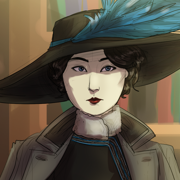|
Kangxi posted:Do you know who you remind me of? The king of the Karnatas hires a servant to hold candles for him in the middle of the night so he can see his wife when they gently caress. That's you. You're a loving candlestick.
|
|
|
|

|
| # ? May 31, 2024 07:10 |
|
That is a burn that will be remembered for ages to come.
|
|
|
|
That insult reminds me of Armando Iannucci, which is a very impressive thing.
|
|
|
|

|
|
|
|
Chapter 25: 1064 to 1077 - Tsenpo Purgyal Gyal 'the Frog' After the sudden death of the Tsenmo Ngawang, Tibet underwent a rapid institutional change as she had left behind few concrete plans about the succession to the throne. Her young son was quickly betrothed to a distant relative from the far west. A rare rebellion broke out in Tibet's holdings south of the Himalayas, near Kiranapura in southern Kosala. The Buddhists were normally the ones who rose in more violent outbursts, whereas the others tended to resist by tax evasion and not showing up for conscription. This was an unusual and significant event, but this revolt was quickly suppressed, without immediate repercussions. The city of Lhasa grew and recovered, and was said to have again equaled its splendor before Ngawang's invasion and seizure of power in the 1050s. The vassal king of Bengal died of old age, and soon the power behind the throne was a dominant landholder outside of Lhasa, who controlled the village of Zaxoi and was a prominent advisor to the late empress. He was an energetic and ambitious figure, and it did not help his ego that he shared the personal name of the late Empress. There are distant rumors of wars in the far west. Nothing to be confirmed or denied. In an unusual step, the head of the Bon Sacred Hierarchy made a public declaration condemning the vassal king of Kamarupa, forbidding him from attending public rituals and receiving blessings from priests. This was a serious and grave declaration, and one theoretically established around the time of the Archpriestess Tse but seldom used for so powerful a figure. This spoke to both the depravity of the king's offenses and also the growing power of religious authority, as Dickey grew to be more ambitious after the sudden success of the war against the Pratiharas. The young Tsenpo, on the other hand, spent much of his time indoors, refusing the suggestions of his maids and household staff, and often stinking of sweat. The world does not stand still on their behalf. In 1065, the armies of the Yuan Dynasty marched out to subdue the kingdom of the Damayanti in Sindh. (OOC I don't know where it pulled this surname from but I like it). The Maharaja Karnpal was a patient and scheming man. He had enlarged the kingdom left to him after the death of Azarmidokht I in 1062, seizing upon the weaknesses of the Pratiharas. Notably, some of the Yuan armies -- some 20,000 men -- had marched overland after sailing around from Guangzhou. This led to some friction with local authorities and merchants. The Yuan protector general complained of price gouging from local merchants. The regent did not want to start another war, but he did not want to help the Yuan any further than he had to. A few of the worst offenders were punished to the full extent of the law - enough to satisfy the Mongols for some time, but not enough to solve the problem. By age 16, the Tsenpo had grown into his own. He had a natural ability for commerce and accumulation of profit, but he lacked many of the social graces of his predecessors. He preferred peace and to be left alone. And the nobles and soldiers would oblige him. When he rarely went among the people, his remoteness and silence were taken as signs of nobility. When it is time for the priests of the Sacred Bon Hierarchy to bless him, he has the ceremony held almost in secret. He asks for prosperity and peace. He has a daughter, named after his mother. Shortly after, word breaks out of a series of peasant revolts break out across multiple provinces of the Yuan Dynasty. A serious and recurring problem, but at the moment nothing to worry about. The Tsenpo's slovenly behavior has soon dispersed much of the confidence that his nobles and court have had in him, and he is soon burdened with the nickname 'the Frog'. He turns out to be vicious in turn and enjoys when others recoil from his poison tongue. Through flattery, negotiation, and bribes, he asks the Yuan for a fine work of craftsmanship. They send him a ji in response. This is soon accompanied by the news that the Yuan subdued the Kingdom of Sindh, which would appear to consolidate their hold over south Asia. This accomplishment is marred by the news that the peasant rebellions have worsened. Several factions - one led by Later Han loyalists, another led by an ambitious peasant - are vying for control in the south and west. These rebels were partly motivated by the locals' perception of the weakness of the Mongolian Army after its failures in Tibet and its long march to Sindh, they are furious at the conquest of their country. The future of the dynasty was in serious doubt. This did not seriously stop the Mongols expansion - on the contrary. The horde under Khutula Khan has decided to move south and further dismember the kingdom of the Pratiharas. If they lose here, then perhaps they are done for. They fall in months. Back in Lhasa, the Tsenpo signs a few laws further consolidating his command over the countryside, with the right to appoint more local leaders, approve changes in taxation, and changes in legal inheritance law. The Empire is less starting to resemble a patchwork of kingdoms and more of a single political entity. The Tsenpo also takes a more proactive stance in the minting of coins. He is concerned over the shortages of hard currency, as well as the use of coin from other kingdoms. This kingdom would be his, and he would need his face to become a symbol of authority. In the far west, the Calipha Eirotatounnlki declares holy war against the ruler of the Maghreb, Awdia, who has taken the style and titles of the great western invaders and worships their gods. Little is known about why or how this has happened. The world to the far west is more known to Tibet, although what filters through to the east is incomplete and confused. We hear of a new church in the north, and of different gods that are worshipped. There is talk of confusion among the religious authorities, and the disintegration of political and spiritual authority. The old priests have vanished, their temples sacked, their pulpits empty. The exception to this would be the church of the Romans. The world would be upended yet again.
|
|
|
|
The world is changing it seems, and not for the better.
|
|
|
|
 Perhaps this will put an end to all the damned stability here and among the Mongols.
|
|
|
|
I've always been a fan of making my rivals into councilors, and then sending them out into plague ridden districts. They drop like flies.
|
|
|
|
That's the Aztecs reformed, the Norse reformed, the Bön reformed... sweet deal!
|
|
|
|
Luhood posted:That's the Aztecs reformed, the Norse reformed, the Bön reformed... sweet deal! Yeah, seeing all these religions prosper is cathartic.
|
|
|
|
“Eirotatounnlki”? I don’t even know what kind of name that is. What is happening with the caliphate in this world? Edit: this is starting to seem like the world where monotheism just didn’t really work out. Catholicism has been in retreat for a while, the European pagans are all reforming. I can’t tell what’s up with Islam but the caliphate sure doesn’t sound like it’s following a stable healthy dynasty. I guess the mongols are Muslim so there’s that.
|
|
|
|
Luhood posted:That's the Aztecs reformed, the Norse reformed, the Bön reformed... sweet deal! At this point the Slavic and that odd Finnish one might even stand a chance. I guess sacrificing the Pope to the Feathery Serpent probably didn't help the Catholics.
|
|
|
|
Slavic almost never reforms because it's holy sites are in really dumb locations iirc
|
|
|
|
Finnic doesn't either, because it's so very, very spread out and the religion is extremely defensive and not inclined to spread. Baltic does a lot though, because all it's holy sites are basically in the one kingdom.
|
|
|
|
I once, and that's in a lot of CK2 games, saw Catharism take over. Seeing Catholicism get so completely hammered this game is kinda strange. I think that Catholicism as a religion in game is lame compared to the pagan religions.
|
|
|
|
Catholicism at least has a bunch of unique mechanics There is nothing lamer than orthodoxy. E: scratch that, Nestorianism is lamer than Orthodoxy Rody One Half fucked around with this message at 02:52 on Aug 15, 2019 |
|
|
|
I'm just hype that there still Jewish horselords around the Pontic Steppe.
|
|
|
|
habeasdorkus posted:I'm just hype that there still Jewish horselords around the Pontic Steppe. I hope they live all the way to the end, nothing really sounds more delightfully silly than "Jewish Horselord".
|
|
|
|
Teched up nomads are no joke. I'm still working through my Jewish Khazar game (around 1150 AD now) and my tech levels are almost as high as anywhere else (4-5 ticks along in everything but some cultural techs). That means I have almost all the nomad buildings, which gives my cavalry insane attack/defense/morale/movement bonuses. So long as I'm not charging across rivers into mountains my 15,000 strong main army beats up 25,000 Caliphate doomstacks with only minor casualties. If it wasn't for nomads tradition of clans declaring independence after a ruler dies I'd probably have run over the world by now. Instead I just control everything from Bulgaria to Lake Baikal. Eventually I'll move down to Israel, but for now it's basically playing whack a mole with angry clan leaders and making sure they don't convert to other religions. The only uncool thing about it is that I haven't had a chance to name a character Genghis Cohen.
|
|
|
|
As I understand it, nomads have a huge, but hidden advantage: armies (well, flanks of armies) that consist of just a single unit type are dramatically stronger than mixed armies, since they have access to much better tactics in combat. However, only nomads can take advantage of this: levies will always be mixed, while retinues can be pure, and nomad armies are all retinues. So as a nomad you can build an army of 10,000 light cav and watch it crush stacks twice its size.
|
|
|
|
Akratic Method posted:“Eirotatounnlki”? I don’t even know what kind of name that is. What is happening with the caliphate in this world? She is a Nubian caliph, and that is a real name. She's also part of the same Hashimid dynasty. https://books.google.com/books?id=t...gngilki&f=false habeasdorkus posted:I'm just hype that there still Jewish horselords around the Pontic Steppe. The biggest kingdom held out for years against the Mongols, and many of them are still independent. There are Rabbinic Jewish nomads, but also Karaites. Meet one of their leaders from the 1050 update - Këlnissa 'the Butcher', a maimed brawny giantess septuagenarian Jewish Khatun. edit: she's probably a kosher butcher Kangxi fucked around with this message at 00:38 on Aug 16, 2019 |
|
|
|
Have the Tengri reformed as well? That would pretty much seal the deal as far as monotheism being just this weird Eastern Mediterranean and Eastern European thing is concerned. Also, any plans to sail off and attack some distant lands now that you've got a port on the Arabian Sea?
|
|
|
|
|
Kangxi posted:She is a Nubian caliph, and that is a real name. She's also part of the same Hashimid dynasty. Oi.
|
|
|
|
The Sandman posted:Have the Tengri reformed as well? That would pretty much seal the deal as far as monotheism being just this weird Eastern Mediterranean and Eastern European thing is concerned. No, and I doubt they will at this point. The Mongols have mostly converted to Sunni Islam, although there are a few Bön holdouts. As for heading west, we'll just have to see how everything is after the plague.
|
|
|
|
I'm getting Graveyard of Empires flashbacks.
|
|
|
|
Chapter 27: 1077 to 1095 - The Plague Years From Wikipedia, the free encyclopedia: The Black Death, also known as the Great Plague or the Plague, or less commonly the Black Plague, was one of the most devastating pandemics in human history, resulting in the deaths of an estimated 75 to 100 million people in Eurasia and peaking in Europe from 1082 to 1086.[1][2][3] The bacterium Yersinia pestis, which results in several forms of plague, is believed to have been the cause.[4] The Black Death was the first major European outbreak of plague, and the second plague pandemic.[5] The plague created a number of religious, social and economic upheavals which had profound effects on the course of world history. The Black Death is thought to have originated in the dry plains of Central Asia, where it traveled along the Silk Road, reaching Anatolia by 1080, where Mongolian invaders catapulted infected corpses over the walls of Constantinople.[6] From there, it was most likely carried by fleas living on the black rats that traveled on all merchant ships, spreading throughout the Mediterranean Basin and Europe. The Black Death is estimated to have killed 40% to 70% of Europe's population.[7] In total, the plague may have reduced the world population from an estimated 350 million to 250–275 million in the 11th century.[8] It took 200 years for the world population to recover to its previous level.[9][10] The plague recurred as outbreaks in Europe until the 19th century. Chronology Origins of the disease The plague disease, caused by Yersinia pestis, is enzootic (commonly present) in populations of fleas carried by ground rodents, including marmots, in various areas including Central Asia, Kurdistan, Western Asia, North India and Buganda.[11] Due to climate change in Asia, rodents began to flee the dried out grasslands to more populated areas, spreading the disease.[12] Nestorian graves dating to 1074-1076 near Issyk-Kul have inscriptions referring to plague and are thought by many epidemiologists to mark the outbreak of the epidemic, from which it could easily have spread to China and India.[13] In March 1999, medical geneticists suggested that both of the great waves of the plague originated in China.[14] The 11th-century Mongol conquest of China caused a decline in farming and trading. However, economic recovery had been observed at the beginning of the fourteenth century. In the 1060s, a large number of natural disasters and plagues led to widespread famine, starting in 1075, with a deadly plague arriving soon after.[15] Epidemics that may have included plague killed an estimated 25 million Chinese and other Asians during the years before it reached Constantinople in 1079.[16][17] The disease may have traveled along the Silk Road with Mongol armies and traders or it could have come via ship.[18] By the end of 1080, reports of plague had reached the seaports of Europe: "India was depopulated, Tartary, Mesopotamia, Syria, Armenia were covered with dead bodies".[19] Plague was reportedly first introduced to Europe via Byzantine refugees from the city of Constantinople in 1080-1081.[20][21] During a protracted siege of the city by the Mongol army under Khutula Khan, whose army was suffering from the disease, the army catapulted infected corpses over the Theodosian Walls to infect the inhabitants. The city fell in 1080, bringing about an end to the Rachites dynasty and independent Byzantine rule. Residents of the city fled, taking the plague by ship into Sicily and the south of Europe, whence it spread north.[22] Whether or not this hypothesis is accurate, it is clear that several existing conditions such as war, famine, and weather contributed to the severity of the Black Death. Middle Eastern outbreak The plague struck various regions in the Middle East during the pandemic, leading to serious depopulation and permanent change in both economic and social structures. It spread from China with the Mongols to the Byzantine Empire, and then the Caliphate-held territories in Anatolia. As infected rodents infected new rodents, the disease spread across the region, entering also from southern Russia. By autumn 1079, the plague reached Alexandria in Egypt, through the port's trade with Constantinople, and ports on the Black Sea. During 1080, the disease traveled eastward to Gaza, and north along the eastern coast to cities in Lebanon, Syria, and Palestine, including Ashkelon, Acre, Jerusalem, Sidon, Damascus, Homs, and Aleppo. In 1080-1081, the disease reached Antioch. The city's residents fled to the north, but most of them ended up dying during the journey.[30] The Abbasid Empire disintegrated into several constituent states, and the Hamdinid Sultanate lost much territory to the fleeing Seljuk Turks from the north. European outbreak The plague saw the collapse of centralized authority in the Italian peninsula, as well as in much of Western Europe, in the former territory of the Franks.[expand?] Mongolian Khanates While Khutula Khan had died in 1081, contemporaneous with the outbreak of the plague across southeastern Europe and the steppe, Mongolian sources attest that he died of natural causes. The empire was split in two parts - the territory occupied by the former Roman Empire went to his son Akhutai, and much of the remainder went to his eldest daughter Tekine. The epidemic spread throughout the steppe, along Mongolian supply lines, throughout the 1080s. Some regions were comparatively unaffected, having been depopulated after the Mongolian campaigns[31]. The Mongols would lose control of much of mainland China, with their authority contested by a noted swordsman, Linghu Fu (令狐復), who claimed descent from a Zhou Dynasty-era general[32]. Linghu would declare the foundation of the Yin (殷) Dynasty, presenting the most serious challenge to Mongol authority in the region. By the mid-1080s, however, the Mongols would launch another invasion of mainland China in an attempt to recover the southern and eastern provinces. Sub-Saharan Africa The Kingdom of Mali would experience a loss of central authority after the death of Queen Namiss from the plague, and other prominent nobles would break away from the government in Niani. The kingdom of Kanem-Bornu, by contrast, survived relatively unscathed due to a spread-out population and aggressive quarantine policy. Tibet/India Records are scarce for the time period, but the historian Sergei Barchenko believes that the plague in Tibet and India came in a second wave in the late 1080s, from travelers fleeing the second Mongolian invasion of China[45]. He cites the surviving correspondence of what he believes to be Radhanite merchants, although the use and veracity of the term are contested [by who?]. The epidemiologist Endo Ryukichi claims that the plague was first spread through the Indian subcontinent through merchants and travelers along the Ganges river basin, before being spread to the Tibetan highlands by 1090. By 1091, the entire subcontinent had reported incidents of plague. The Tsenpo and three of his four children had died of plague by the end of 1091. The Radhanite sources report that the last daughter of Tsenpo Gyal barricaded herself in a castle, and told fanciful stories of a pile of corpses built up outside by angry peasants. There are very few surviving records from this period from either the ruling council, Nor from the vassal kings. The army was unable to seriously respond to reports of rebel forces, and several areas broke away from the empire at this time. In addition to the Radhanite letters, other historians of the period refer to the Blue Annals, a 14th-century work by Drogmi Yonten Drakpa. While of doubtful authenticity, his is one of the few Tibetan sources which directly refer to the plague of the 1090s. His history, written in a poetic farce in verse, alludes to the life of the 'snot-nosed' Tsenpo Gyal, and then describes a history of holy wars without armies, Empresses without kingdoms, And cities without people, where the Mongols would be the saviors of the world, the dispellers of delusion, and the restorers of peace. Demographic effects For Tibet and the Indian subcontinent, the effects of the plague are difficult to estimate. Barchenko's estimate draws from the high numbers of nobility that have died in the plague, noting that 30-40% of the royal family had perished, and so the commoners would have died in greater numbers - between 50-60%. Endo, by contrast, says that this only indicates the hereditary nobility's lack of a coherent response, saying that only one-third of the Tibetan empire's population would have died. See also Plague of Justinian Black Death (film) Black Death in China Black Death in Poland The Book of Living and Dying CCR5, a human gene hypothesised to be associated with the plague Danse Macabre Death Doomsday Book (novel), a science fiction novel written by Chu Weiming Geisslerlieder Last outbreak of bubonic plague in England (1906–1918) The Legend of Queen Sara Plague doctor Plague doctor costume Ring a Ring o' Roses The Seventh Seal, a film directed by Ingmar Bergman Timeline of plague
|
|
|
|
Outside Tibet, this world looks like a mess.
|
|
|
|
I like independant Aztec Sardinia and Rome. Do you ever get to learn about how the AI reforms religions? Presumably, they had the same options as we did when we reformed.
|
|
|
|
Chatrapati posted:I like independant Aztec Sardinia and Rome. Do you ever get to learn about how the AI reforms religions? Presumably, they had the same options as we did when we reformed. They have almost the same options, except each 'pagan' religion has their own unique doctrine, which you can see here if you scroll down a bit. For Bön, we voted for Harmonious, which is like having both Meritocracy and Equality traits. We picked that, as well as Animistic, Hierocratic, and Unyielding. Unyielding, as it turns out, has been very good for us so far. The Aztecs picked their own unique doctrine, Invaders, which adds all the bonuses of Unrelenting, Seabound, and Bloodthirsty Gods. They picked Temporal, Daring, and Warmongering. The Norse picked Sons of Ragnarok, which gives them both Daring and Seabound. They also picked Temporal, Warmongering, and Enatic Clans, which affects the succession laws and allows women to take multiple consorts. Kangxi fucked around with this message at 23:08 on Aug 20, 2019 |
|
|
|
More like daughters of ragnarok
|
|
|
|
Welp, the Norse in this world are going to basically be the Obsidians from Red Rising. I for one welcome our gigantic, axe wielding masters.
|
|
|
|
So does that mean the Fylkir is some terrifying Swedish murder-queen?
|
|
|
|
|
|
|
|
megane posted:So does that mean the Fylkir is some terrifying Swedish murder-queen? Her grandmother, Malmfrið, was the one who reformed the Fylkirate. She was the last Queen of Sweden from the House of Munsö. She and all her surviving children died of the plague in 1082.
|
|
|
|
Kangxi posted:
Now isn't that a story! You reform the faith only for your ENTIRE FAMILY to be taken out by a mysterious illness some years later. That must be a sign from the divine!
|
|
|
|
Chapter 28: 1095 to 1100 - Tsenmo Purgyal Ngawang II With the plague receding from Tibet in the first months of 1095, the Tsenmo Ngawang began the work of surveying the damage and working with the surviving nobles to restore the realm. She gathered a close circle of vassal kings - all of whom, it was noted, kept an intense devotion to the faith. She had ordered the construction of further barricades and fortresses, which could be maintained even with a reduced complement of troops. The empire of Tibet had lost greatly - not as much as other kingdoms, but it was deeply unsettled after the loss of so much of its population. The empire shorn of the lands of the Rajputs - still led by a descendent of Yongdagmo the Butcher - and of the land of Vidarbha. In the northwest, some lands around Yopurga which had passed to Tibet by inheritance had renounced Lhasa's authority and were ruled by a Buddhist lord. Still, trouble persists. Old favors are called in from vassal kings. The holy war, called by the sacred hierarch in the middle of an epidemic, is quietly drawn to a close. It is another stain on the authority of the church. The Tsenmo orders the construction of new buildings, but the workers and craftspeople are demanding higher wages because of unsafe working conditions and the constant fear of being caught in public by the disease. She has no choice but to agree. A peasant revolt breaks out near the village of Kunggar. It is tough going - the standing army was dispersed years ago. But the army marches forth, with the Tsenmo at its head. She orders the troops to advance, with her at the very front, demanding they kill, kill without hesitation, And she is cut across the head. She staggers back, holds her hand to cover her wounded eye. The battle is still won, with minimal cost. And she has the traitor buried alive. He does not even scream. The damage was such that she could not be fitted for a prosthesis, but she was soon able to recover. She converses with the vassal queen of Kamarupa, who talks her into learning Assamese. Ngawang grows weary. The hordes of treasure she has accumulated no longer interest her. She has nightmares about the battle, and of the stenches of bodies lying in the streets and in the palaces, swollen up like animal skins and their noses, lips, and fingers blackened with rot. She wonders why she was still alive out of all the others. In the west, rumors of war. As there always are. Nearer abroad, more peasants revolting, in Zhongba. The army chases them further west, to Gê'gyai. She leads the charge and prepares to duel the traitor, that uppity little shepherd. She sees red, and then nothing at all. She hears the cheers of her men and knows the battle is won, though in her gut she knows there is little time left for her. She soon passes from her wounds in the dying months of 1099. She had outlived her parents and all of her siblings. None of them had children. The Empire of Tibet passes to a distant cousin. The Shi'a war fails, and Akhutai Khan still sits upon the throne of the Romans. And to Tibet's east, the Mongols again rule China. Not the same clan as Temulun Khan, however - a warrior named Shuogu has seized the capital for herself and crushed the fledgling Yin Dynasty, massacring them all near Sichuan. Kangxi fucked around with this message at 04:10 on Aug 23, 2019 |
|
|
|
Musical Thrones over there!
|
|
|
|
A Timid eleven-year-old as Tsenmo while the vassal kings rule, eh? 
|
|
|
|
State of the World - 1100 A military conference, held at the Hanlin Academy's Bureau of Translation, the Empress' personal retinue, and the Empress herself. Shuogu: I simply don't know where that walking corpse has been hiding - we'll have to send a detachment of troops out to find him. [A group of scholars enters, each clasps their hands and bows.] Shuogu: I had a good discussion with your colleague yesterday. This is your map? Li Yuanjue [looking relieved]: Yes, your majesty. Shuogu: They spoke very well about the east and the south; we will have to recover the lands up to the Han in the north and near the Yuan river valley in the south. But what do you have for me today? [Li nods to his assistants, who dramatically unfold a second map across a lacquered table, lavishly decorated with city names, rivers, and drawings of landmarks.] Li Yuanjue: Here is a map of the near west of the empire, your majesty. In the north, closest to us on the map here is the Khanate of Kokochu, and we can go south all the way to the southern trip of Tianzhu, at Shiziguo. Shuogu: Explain to me the Mongols. Li Yuanjue: Your majesty. Shuogu: No, do not be concerned. I know it is complicated. Try to explain it simply, as if I were a pupil of yours. I did not become empress because I was able to remember all of Confucius. [She smiles but not with her eyes, and toys with the corner of the map with her thumb. There is a silence of a few seconds, as Li glances around the room.] Li Yuanjue: Then. In response to the query of your majesty. The lands here, from the northern plains to this mountain range here and the Aral Sea are ruled by Kokochu Khan. He is married to a Tibetan princess and worships their gods. He assumed control of this after the death of Tekine Khan, daughter of Khutula Khan, son of Temulun Khatun. This was seven years ago, she had no suitable children, the khaganate passed to him. He is skilled on horseback and in the arts of warfare. Shuogu: How many troops does he control? Li: I am told almost twenty thousand. To his west is Bogorchu, who rules the steppe between Lake Buku and this mountain range here, which the locals call Ur Yal, Urr, or Oralu. He is a brave man, scarred, and physically strong. He follows the religion of the Hui. Shuogu: But that is not the entire empire. Who is to the west of him? They are not on this map, your majesty. [He gestures to his assistants, who produce a smaller, and less detailed map labelled 'the western sea'.] There are two more: there is Ajai Khagan, who rules a vast plain with much fertile grazing ground, and that is divided by three rivers - the Wu'erjia, the Dun, and the Diniebo. Shougu: Who are the peoples to his north and south? Are those the Kesa? Li: Yes, they are Kesa. They are people of the horse and felt tent, like you, and they are formidable in the arts of warfare. They are pastoral, though they are also willing to trade exotic goods and their merchants deal with furs, wines, and isinglass. They, also like the Hui, have only one god, though they are split into two separate groups over a dispute in their code of laws and which set of laws are legitimate. To his south, across the Black Sea, is Akhutai. His father was Bugunutei, the late emperor of the Yuan Dynasty. Bugunutei was Khutula's younger brother, and he was Temulun's son. Akhutai now rules the empire of Fulin, holding on to the lands conquered by Khutula Khan. That empire's territory extends through many hundreds of li, and the people lived in walled cities. They produce jade, pearls, amber, glass, asbestos cloth, coral, porphyry, chalcedony, and many luxurious woven goods. They are the great empire to the west, as we are to the east. [Shuogu looks over the map impassively.] Shuogu: Which one of you knows of Tibet? [A younger woman steps forward and bows.] Deng Qiyun: Deng Qiyun, of Sichuan, a scholar of the fourth rank, your imperial majesty. Shuogu: Right. Tell me what you know. [Deng, too, hesitates. She stares at the map, collecting her thoughts.] Shuogu: You're speaking only to me. [Deng clears her throat.] Tibet is wounded, but not permanently, from the great plague of the past decade. The northern pastoralists and nomads were far away from the centers of plague, and they are the ones that form the most skilled cavalry. The southern cities, however, along the Heng River, such as Mahodaya, Gauda, and Boluonai, are more affected, having lost one person out of every three. [Deng continues.] Their current Tsenmo is a young girl of 11 years. As of now, power is held among the vassal kings, each with their own interests and ambitions. Some want to wage war, as they have been taught that the empire must expand in order to survive. Others want to enrich themselves. Only some of the vassal kings are of the same royal family. Others are descended from military leaders or prominent tribal chiefs. The priesthood, while it has never been as powerful as it was two centuries ago, is now seen as less weak and ineffectual after the years of the plague. There are still Buddhist sects and secret monasteries in the area south of the Himalayas and to the west of the Pamir mountain range. [Chucai, the military governor of the northwest, speaks.] Chucai: The motherfuckers give us enough trouble. They keep killing the tax collectors. Shuogu: That's enough of that. [He looks down and does not talk.] Shuogu: We'll have to put off an invasion of them for the time being. Most of the troops that were well adapted to mountain terrain had died after the battles near Chengdu. We can try and conscript the troops from the southwest, in what was Nanzhao but there are only so many of them and we will need to hold the line against the Kingdom of Pagan. We will need to identify those regional commanders that are most reliable. [She leans over the map and dismisses Deng with a wave of her hand. Deng wishes she had the courage to say something, anything at all. She steps back.] Shuogu: Tell me about Tianzhu. From north to south. What are the kingdoms here? Li: This is the kingdom of the Pratiharas, have moved west from their old capital near Deli, to, I have heard, the fort of Bhatner. Aside from the lands of the northern Yindu River, they still retain the lands of the Gujaras. Shuogu: What is this kingdom between them? Li: That is the land of the Rajputs, which was once a part of Pratihara. It was conquered by the Tibetans, but then lost to the empire after the great plague. They are ruled by a descendant of their first vassal king, Yongdarmo the Butcher. The west is mostly desert and impassable, but the east - or south of the Aravalli mountain range, is more fertile. They grow kinds of wheat, barley, pulses, and oilseeds. They are ruled from the city of Shakambari. Li: To their south are the Tamils, and their queen claims to rule all of these multiple kingdoms. These separate parcels of land here. They rule from the city of Tanjavur. They grow rice, beans, millet, and coconut, and carve sculptures from pith. They were allies to the previous northern dynasty, though I do not know if they can raise an any yet again. Their vassals are the Kingdom of Lanka, ruled by the same family for centuries. In the middle here, is the kingdom of Karnata, ruled from a city on the coast called Guo'a. As the name suggests, they grow many fruits there. Their ruling king is of the Zhao Dynasty, and... Shuogu: That doesn't sound like a local king. How did that happen? Li: Well. This is a story I have heard second hand. But it is what we know, so I can tell you. During the fall of the previous Tang Dynasty, some two centuries ago, a group of exiles, loyal to the defeated dynasty, went west to found their own kingdom. They were removed from power, and have not held it since. But now, either a descendant of them has the throne, or someone claiming to be a descendant of them has power. I cannot yet discern which of these is true. [Shuogu stares at the location on the map.] Shuogu: After two centuries. Their loyalty is incredible. Shuogu: So. What of the west? Li: To the west of the Pratiharas, we have the Samma dynasty. Their Maharaja is an impatient man, and he has crushed many rebellions against his rule. He rules from Kandahar. The west of his land is barren, but the east is prosperous from the trade along the Yindu river. Li: Further to their west, we have the Seljuk Turks. We don't really know where they came from, probably from the northern desert. They've driven out most of the Hamdanids from Bosi. They rule from a port named for the moon, in a gulf well-suited for commerce. And to the furthest west, there is a valley with two great rivers. These extend all the way up to the northern plains. They are ruled by an evil queen, who has despoiled the name of their benevolent dynasty. They border Fulin, ruled by the Mongols. [He steps back.] After this, we know less and less, as travelers are scarce since the time of the plague. And what they could tell you is all the same. Plague, death, the loss of kingdoms and authority. Shuogu: Rumors are better than nothing. Let's hear them. Li: The head of the Luminous religion resides there. He has supreme authority over other kings in the west, we are told. We have copies of their sutras in our archives. He resides in a former imperial capital, having been evicted from another capital which has been burned many times. He is the head of their church, and he has restored the land of an ancient family to practice the rites of his people and conduct the veneration of the oneness of heaven. To his east, the descendants of nomads have settled down as a royal family. They now speak the language and wear the clothes of the tribes that had first settled there. To the north, there are the Aleiman. They drink a beverage made from barley. They are extremely tall and eat chunks of fermented cow's milk, which stinks. To their west were people called Farangi, but they are now subject to barbarian rulership. They were invaded from the west, a nomadic people who lived on the ocean and ate whale. They came from the sea in their great ships and none were able to withstand them for decades. To their east are people who venerate the same gods and follow the same rituals as in Tianzhu. They live by a great icy sea and live on sandy land and are called Bomeila. There is also a single vast island off of the coast near Akhutai Khan and the far western kingdom. We first thought this was like the islands off our own eastern coast, but they are not the same. They eat fish and a round brown vegetable which grows underground - one of the few things that can be grown upon that rock. They, too, are in a period without a single ruler, and many warlords squabble over the land. They were ruled by aristocrats brought over by the seafaring barbarians. In the furthest north, the sun does not rise for half a year. It is very cold and inhospitable and very few people live there. Great monsters live in the forests. That kingdom is ruled only by women, and they are skilled in warfare and slaying their foes with a single blow of a hammer. Both this kingdom, as well as the kingdoms of the luminous religion, fund orders of warrior monks. They train, meditate, and don special armor and fight near the marshes and swamplands. To the furthest west, there is a great kingdom, at the very western edge of the earth. They produce metals, fine glassware, and grind their grains with water wheels. They wash their hair and teeth with fine herbs and mints. They were invaded by nomadic sea dwellers, but have since recovered much of their lands. [Shuogu nods politely.] Shuogu: Thank you. I have enjoyed these fanciful stories. But there is much elsewhere to discuss. Chucai! We will need to summon the chancellor and the head of the executive bureau. I am late for my next order of business... 
Kangxi fucked around with this message at 16:20 on Aug 25, 2019 |
|
|
|

|
| # ? May 31, 2024 07:10 |
|
 e: holy poo poo he's a cannibal this world is loving wild
|
|
|
























